History
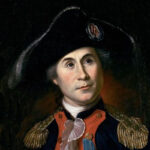 Pirates, as we know them, are criminals who hijack ships to rob them of anything of value on board. Sometimes however, a “pirate” can actually be working for the government, or at least on behalf of the government. Such was the case on April 10, 1778, when Commander John Paul Jones and his crew of 140 men aboard the USS Ranger set sail from the naval port at Brest, France. They headed toward the Irish Sea. Their mission was to begin raids on British warships. This was the first mission of its kind during the Revolutionary War. These missions weren’t called piracy, but when we compare the two acts, they pretty much were piracy. They just weren’t for personal gain, but rather for the good of the country and the war effort. No one was safe, not passengers and certainly not the crew.
Pirates, as we know them, are criminals who hijack ships to rob them of anything of value on board. Sometimes however, a “pirate” can actually be working for the government, or at least on behalf of the government. Such was the case on April 10, 1778, when Commander John Paul Jones and his crew of 140 men aboard the USS Ranger set sail from the naval port at Brest, France. They headed toward the Irish Sea. Their mission was to begin raids on British warships. This was the first mission of its kind during the Revolutionary War. These missions weren’t called piracy, but when we compare the two acts, they pretty much were piracy. They just weren’t for personal gain, but rather for the good of the country and the war effort. No one was safe, not passengers and certainly not the crew.
Commander John Paul Jones, will always be remembered as one of the most daring and successful naval commanders of the American Revolution. John Paul Jones was born under the simple birth name of John Paul on July 6, 1747, in a small cottage in Arbigland, Scotland, to John Paul Sr and Margaret Paul. His dad was a gardener, but Jones found his calling not in gardening, but at sea. He earned an apprenticeship with the British Merchant Marine at the age of 13. His seafaring adventures would eventually take him to America and, like many other sailors before him, Jones got involved in the slave trade. However, the realities of human trafficking repulsed him, and he returned to shipping cargo duties.
1773 found Jones in a very difficult situation. He murdered a mutinous sailor on the island of Tobago in self-defense…which is not really murder, but maybe in those days things were different. Whatever the case may be,  Jones believed he wouldn’t receive a fair trial, so he fled to America. It was there he added the last name “Jones” to conceal his identity. Jones needn’t have worried, because the American colonies were too busy stoking the flames of war with the British to have noticed his past. When the American Revolution broke out in 1775, Jones who remembered Britain’s cruel treatment of the Scots, decided that he would side with the colonists. He joined the new Continental Navy.
Jones believed he wouldn’t receive a fair trial, so he fled to America. It was there he added the last name “Jones” to conceal his identity. Jones needn’t have worried, because the American colonies were too busy stoking the flames of war with the British to have noticed his past. When the American Revolution broke out in 1775, Jones who remembered Britain’s cruel treatment of the Scots, decided that he would side with the colonists. He joined the new Continental Navy.
Jones began skillfully attacking British ships off the American coastline and expanded his operations from there. He first captained the USS Providence, set sail to Nova Scotia, and started capturing British vessels. Next, he took command of Ranger and set course to France, where his vessel was saluted by the French Admiral La Motte Piquet. It was the first American vessel ever to be recognized by a foreign power…pretty good for a new country. In 1779 Jones made history as one of the greatest naval commanders of the Revolutionary War. His shining moment came when, while En route to raid British shipping, Jones’ warship, Bon Homme Richard, came head to head with the more powerful English warship HMS Serapis off the North Sea. The battle went on for three hours between the two vessels. At one point, Jones slammed Bon Homme into Serapis, strategically tying them together. As the story goes, when the British asked if Jones was ready to surrender, he famously responded, “I have not yet begun to fight!” Inspired by Jones’ bravado, one of his naval officers tossed a grenade onto Serapis. The severe damage caused the British to surrender in the end. Jones’ became an 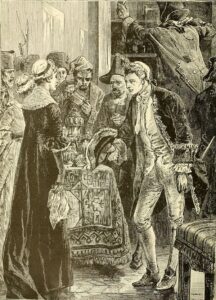 international hero. After the war ended, the Continental Navy dissolved due to lack of funds. Jones was dubbed the father of the United States Navy.
international hero. After the war ended, the Continental Navy dissolved due to lack of funds. Jones was dubbed the father of the United States Navy.
Jones retired to Paris, but his health took a turn for the worse. On July 18, 1792, he was found dead in his apartment at the age of 45. He was laid to rest in a French cemetery, but the plot of land was later sold and forgotten. Over one hundred years would pass before the United States was able to recover Jones’ remains with the help of French officials. After much research, his body was located and exhumed, and to the surprise of French pathologists, Jones’ body was excellently preserved. His initial autopsy concluded that the cause of his death was kidney failure, with later clinical studies believing his condition was exacerbated by a heart arrhythmia. The United States received Jones’ remains and buried them in a tomb inside the chapel of the U.S. Naval Academy in Annapolis, Maryland.
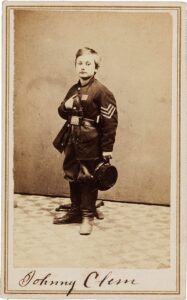
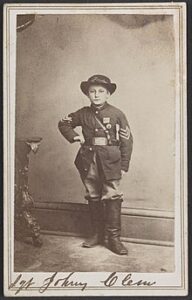 During the Civil War, military personnel was often short supply, and so, soldiers weren’t always adults. Sometimes, children enlisted, and sometimes they were “hired” on as messengers, scouts, and servants. They also might be hired on as musicians, such has drummers or buglers. On ships, children carried powder to fire the cannons, earning the nickname “powder monkeys.” In fact, one in five soldiers during the Civil War was under the age of 18.
During the Civil War, military personnel was often short supply, and so, soldiers weren’t always adults. Sometimes, children enlisted, and sometimes they were “hired” on as messengers, scouts, and servants. They also might be hired on as musicians, such has drummers or buglers. On ships, children carried powder to fire the cannons, earning the nickname “powder monkeys.” In fact, one in five soldiers during the Civil War was under the age of 18.
One such musician was Drummer John Joseph Klem. A popular legend suggests that Klem served as a drummer boy with the 22nd Michigan at the Battle of Shiloh. Legend has it that Klem came very near to losing his life when a fragment from a shrapnel shell crashed through his drum, knocking him unconscious and that subsequently his comrades, who found and rescued him from the battlefield, nicknamed Klem “Johnny Shiloh.” Klem slayed enemies in the Battle of Chickamauga…shooting a Confederate officer. Though Klem was only 10 years old, the Union made him a sergeant. Now imagine taking orders from a 10 year old sergeant.
Klem was born on August 13, 1851, to Roman and Magdalene Klem. His mother was killed crossing the railroad tracks when he was just 9 years old. As devastating as that was, his father’s second marriage was worse. John did not get along with his stepmother, and I suppose that could have contributed to his wanderlust spirit. He attended school in Newark, but often skipped school so he could drill as a drummer boy with a local unit…Company H, 3rd Ohio Volunteer Infantry. Like many people of that time, Klem felt strongly about the Civil War, but it was probably unusual for such a young boy to feel that way. Most likely the main factor the problems with his stepmother, making life at home unpleasant. His relatives joining up was probably another factor.
Motivating Klem was the fact that many of his relatives had enlisted in the army. He also deeply admired the president. In fact, he so admired President Lincoln that he changed his middle name to Lincoln. Because of his young age, recruiters turned Klem down when he tried to enlist. Several regiments passed through Newark on the way to the War. Klem immediately went to each and tried to join up, but each time he was turned down because of his age. He tried a new tactic, and traveled by train to try to enlist. That failed too, because he was always recognized by a friend or relative and sent home. Finally, Klem just ran away from home, to join the Army in 1861, at the age of 9. He finally got far enough away from home that they let him stay. Even then, he didn’t really enlist, because he was still too young. They allowed him to join the Michigan unit because they knew he would not give up until somebody let him join. When he offered his services as drummer to a company commander of the Third Ohio Volunteer Regiment, the captain looked him over and said he wasn’t “enlisting infants.” Johnny then tried to join the Twenty-second Michigan Regiment and was refused. Finally, he simply “went along with the regiment just the same, as a drummer boy, and though not on the muster roll, drew a soldier’s pay of thirteen dollars a month.” His pay was contributed by officers of the regiment.
At some point, Johnny Klem became Johnny Clem, although I am not sure just when. When Johnny Clem enlisted in the Army, legally or not, his intention was to stay. He might have been just a drummer boy at first, but when the shell hit his drum, he was not scared. Over the years of his service, he proved himself to be an invaluable member of the unit. He gained fame for his bravery on the battlefield, and became the youngest soldier ever to achieve the rank of sergeant, and I expect that record still stands. Clem retired from the United States Army in 1915, having attained the rank of brigadier general in the Quartermaster Corps. At the time of his retirement, he was the last veteran of the American Civil War still on duty in the US Armed Forces. By 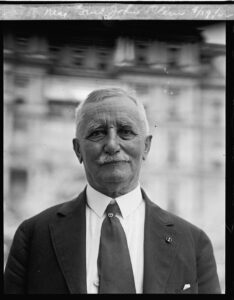
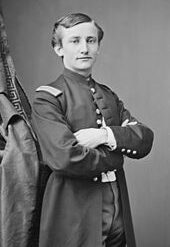 special act of Congress on August 29, 1916, he was promoted to major general one year after his retirement.
special act of Congress on August 29, 1916, he was promoted to major general one year after his retirement.
Clem was married twice. He first married Anita Rosetta French in 1875, and after her passing in 1899, he met and married Bessie Sullivan of San Antonio in 1903. Sullivan was the daughter of a Confederate veteran. Clem enjoyed that fact, and often said, that he was “the most united American” alive. Clem was the father of three children. After his retirement in 1915, Clem lived in Washington DC before returning to San Antonio, Texas. Just as he had as a child on the battlefield, Clem defied the odd, living a long and healthy life. He died in San Antonio at the age of 85 on May 13, 1937, and was buried in Arlington National Cemetery in Arlington County, Virginia.
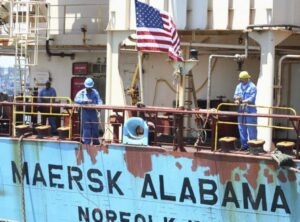 It seems to me that whenever we, as a nation or a people, get a little lackadaisical concerning the safety of our citizens, we find ourselves falling victim to the very thing we thought was no longer a threat. I think most people know that pirates used to be a big problem, but I wonder if people realize that they still are a big problem. We all thought that airplane hijackers were a thing of the past…until 9-11, and then we knew that evil still existed, no matter how tightly we closed our eyes to it.
It seems to me that whenever we, as a nation or a people, get a little lackadaisical concerning the safety of our citizens, we find ourselves falling victim to the very thing we thought was no longer a threat. I think most people know that pirates used to be a big problem, but I wonder if people realize that they still are a big problem. We all thought that airplane hijackers were a thing of the past…until 9-11, and then we knew that evil still existed, no matter how tightly we closed our eyes to it.
As far as the United States was concerned, pirates had not captured a ship sailing under the American flag since the 1820s, so why would it happen now? They assumed that our ships were safe…maybe because they flew the American flag or maybe because pirates were really a thing of the past. On April 8, 2009, they found out just how wrong they had been, when the MV Maersk Alabama was hijacked off the coast of Somalia. This hijacking was a very big deal, and drew worldwide attention to the problem of piracy in the waters off the Horn of Africa. Decades of instability in Somalia, as well as a lack of policing in its territorial waters led to a resurgence of piracy in the region that peaked in the late 2000s. Evil simply can not be expected to fade away. In fact, just a day before the attack, the Maersk Alabama received warning from the United States government to stay at least 600 miles off the coast of Somalia. Unfortunately, Captain Richard Phillips decided that keeping the ship about 240 miles from the coast would be sufficient. It was to be a decision that was later criticized by members of his crew, who saw it as reckless.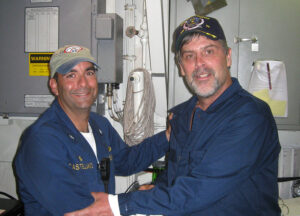
On April 8, members of the crew saw a skiff carrying four armed pirates approaching their ship, Immediately, they initiated the protocol for a hijacking. Chief Engineer Mike Perry got most of the crew to a safe room and managed to swamp the pirates’ craft by swinging his ship’s rudder. Nevertheless, the pirates were able to get onboard and take Phillips hostage. After one of the pirates was injured fighting with the ship’s crew, the remaining three pirates kidnapped Phillips and fled in a lifeboat, planning to use him as a bargaining chip.
The USS Bainbridge arrived early the next morning along with another United States Navy vessel. A three-day standoff followed. The pirates continued to hold Phillips hostage in the lifeboat. Negotiation attempts failed, and at one point the pirates fired at the destroyer, doing no damage. Finally, on April 12, Navy SEAL snipers opened fire on the lifeboat. It must have seemed to Phillips that they had sacrificed his life, to save the ship, but in a stunning display of accuracy, the SEALS firing from a ship’s deck through the windows of the tiny boat, hitting all three pirates in the head, killing them instantly. Phillips was unharmed, and hopefully came away a much  wiser man and a much better captain to his crew.
wiser man and a much better captain to his crew.
The surviving pirate, Abduwali Muse, was taken into custody and later sentenced to over 33 years in United States prison, having been tried as an adult, even though he and the other hijackers were reportedly all teenagers when they hijacked the MV Maersk Alabama. Piracy is still an issue in the region…even targeting the MV Maersk Alabama herself four times 2009 and 2011, each of which was repelled by armed security teams. The attacks were attempted, but being ready and willing to fight staved off the attacks.

 Over the years, we have had many fashion changes. Clothing went from long skirts to mini-skirts, and back again. Jeans went from straight legs, to bell bottoms, to skinny jeans, and everything in between. Furniture went through some of the same changes. Victorian, modern, contemporary, rustic, and every other type of furniture have been the furniture of choice over the years too. Even cars have gone through “fashion” changes over the years…some were so drastic that we don’t even recognize the car anymore, like the Mustang.
Over the years, we have had many fashion changes. Clothing went from long skirts to mini-skirts, and back again. Jeans went from straight legs, to bell bottoms, to skinny jeans, and everything in between. Furniture went through some of the same changes. Victorian, modern, contemporary, rustic, and every other type of furniture have been the furniture of choice over the years too. Even cars have gone through “fashion” changes over the years…some were so drastic that we don’t even recognize the car anymore, like the Mustang.
When we think of fashion trends, we seldom focus on tires, but maybe we should. Tires have changed so much over the years, and I’m not really talking about quality. I’m talking about style. I suppose that since I’m married to a mechanic, these things might stand out to me more than other people, but I remember the different styles that my husband, Bob likes over the years, and when he would go out of his way to change the way his current tires looked. He had cars with the small white stripe around them, and he had “raised white letters” on his tires, which I must say were probably his, and my favorites. It was a cool look. In the early 1900s, the companies came out with Whitewall tires or white sidewall (WSW) tires. These tires had a stripe or entire sidewall of white rubber. These tires were most commonly used to around the mid 1970s. To me, these were not a good looking tire, especially if it was the entire sidewall, but they were a trend I suppose.
The use of whitewall rubber for tires was started by a small tire company in Chicago called Vogue Tyre and Rubber Company. They made the tires for their horse and chauffeur drawn carriages in 1914. Early automobile tires were made of pure natural rubber. To make the tread wear better, they mixed in various chemicals mixed into the tread compounds. Apparently, zinc oxide, a pure white substance that increased traction and also made the entire tire white, worked the best. In the end, white rubber did not have the endurance that was needed. They used carbon black only in the tread, and that with the white rubber produced tires with inner and outer sidewalls of white rubber. Eventually, entirely black tires became available, but since they were still made of rubber, a scrape against the curb would reveal the white rubber inside. That was actually how they finally arrived at the raised white letters that Bob and I liked so much.

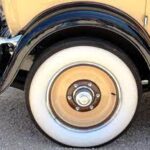
Tires, like any other “fashion trend,” have changed over the years. If it wasn’t the sidewall, it was the tread design. As the manufacturers figured out better ways to make the tire grip the road better, they made the roads a safer place to drive. While their ideas weren’t always about the way a tire looked, that was a big part of the tire’s design, because if it didn’t look good, people wouldn’t buy it, even if it was a good tread design.
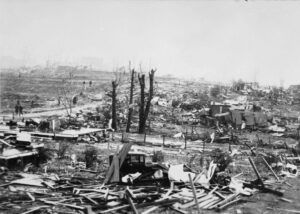 Tornadoes are a common storm in some parts of the United States. The most common area for them is called Tornado Alley. Usually, when storms go through, you might hear of tornado watches. That doesn’t mean that there are multiple tornadoes in an area, but it could. In 1936, beginning on April 5th and extending through April 6th, the states of Mississippi and Georgia found themselves in the middle of a tornado outbreak, which is several tornadoes in an area, of course. This is the only continuous tornado outbreak in United States history to produce more than one tornado with triple digit death tolls. Also, severe flash floods from the associated storms caused millions of dollars in damage across the region.
Tornadoes are a common storm in some parts of the United States. The most common area for them is called Tornado Alley. Usually, when storms go through, you might hear of tornado watches. That doesn’t mean that there are multiple tornadoes in an area, but it could. In 1936, beginning on April 5th and extending through April 6th, the states of Mississippi and Georgia found themselves in the middle of a tornado outbreak, which is several tornadoes in an area, of course. This is the only continuous tornado outbreak in United States history to produce more than one tornado with triple digit death tolls. Also, severe flash floods from the associated storms caused millions of dollars in damage across the region.
The storm, called the Tupelo-Gainesville Outbreak, produced at least 12 tornadoes. The outbreak took place over two days, April 5th and 6th, but was really just about 12 hours in duration. The storm hit Tupelo, Mississippi at 8:30pm on April 5, 1936. It was the fourth-deadliest tornado in United States history. The storm came out of a group of storm cells, and first touched down in a rural area about eight miles from the city. The twister killed a family of 13, sweeping their house away as the tornado made its way toward Tupelo. Many more were injured before it even reached the city. The tornado was retroactively rated an F5 on the Fujita scale, it caused total destruction along its path through the Willis Heights neighborhood. In that area were a number of well-built large mansions that were blown away like a house of cards.
The tornado missed the business district, and instead hit residential areas, sadly…increasing the death toll. The Gum Pond area of Tupelo was the worst hit. Homes along the pond were swept into the water with their 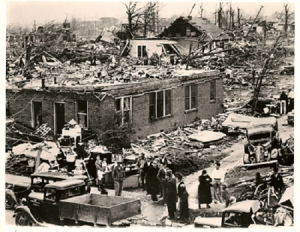 victims. The majority of the bodies were found in Gum Pond, the area which is now Gumtree Park, but many bodies were never recovered from the pond at all. The winds were so strong, that pine needles were embedded into trunks of trees. The tornado took out the large concrete Battle of Tupelo monument as it exited the city’s east side. According to records, the Tupelo tornado leveled 48 city blocks and between 200 and 900 homes. It officially killed at least 216 people and injured at least 700. The tornado destroyed the water tower and produced numerous fires in its wake. Thankfully, overnight rains, which left knee-deep water in some streets put out the fires. Though 216 remained the final death toll, 100 persons were still hospitalized at the time it was set. Subsequently, the Mississippi State Geologist estimated a final, unofficial death toll of 233. Surprisingly, one-year-old Elvis Presley and his parents were among the survivors, a fact I never knew about him.
victims. The majority of the bodies were found in Gum Pond, the area which is now Gumtree Park, but many bodies were never recovered from the pond at all. The winds were so strong, that pine needles were embedded into trunks of trees. The tornado took out the large concrete Battle of Tupelo monument as it exited the city’s east side. According to records, the Tupelo tornado leveled 48 city blocks and between 200 and 900 homes. It officially killed at least 216 people and injured at least 700. The tornado destroyed the water tower and produced numerous fires in its wake. Thankfully, overnight rains, which left knee-deep water in some streets put out the fires. Though 216 remained the final death toll, 100 persons were still hospitalized at the time it was set. Subsequently, the Mississippi State Geologist estimated a final, unofficial death toll of 233. Surprisingly, one-year-old Elvis Presley and his parents were among the survivors, a fact I never knew about him.
After ravaging Tupelo, the storm system moved through Alabama overnight and reached Gainesville, Georgia, at around 8:30am. When the storm hit Gainesville, it became a double tornado event. One tornado moved in from the Atlanta highway, while the other moved in from the Dawsonville highway. As they came into town, the two tornadoes then merged into one on Grove Street and destroyed everything throughout the downtown area…leaving 10 foot high piles of debris in some places. The worst tornado-caused death toll in a single building in United States history was at the Cooper Pants Factory. The multiple-story building was then filled with young workers, who had just arrived to work. The structure collapsed and caught fire, killing about 70 people. At the Pacolet Mill, 550 workers moved to the northeast side of the building and survived. Many people sought refuge in Newman’s department store, and its collapse killed 20 people. In addition to the complete destruction that occurred throughout downtown Gainesville, residential areas throughout the city were 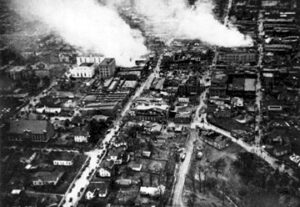 devastated as well, where 750 homes were destroyed, and 254 others were badly damaged.
devastated as well, where 750 homes were destroyed, and 254 others were badly damaged.
The Tupelo-Gainesville Outbreak took the lives of 454 people, 419 by the two main two tornadoes alone. This outbreak is the second deadliest ever recorded in United States history. Although the outbreak was centered on Tupelo, Mississippi, and Gainesville, Georgia, where the fourth and fifth deadliest tornadoes in United States history respectively occurred, other destructive tornadoes associated with the outbreak hit Columbia, Tennessee; Anderson, South Carolina; and Acworth, Georgia.
 As Easter (Resurrection Day) arrives, I find myself thinking first of Good Friday. As a Christian, I have always felt quite saddened about the need for our savior to die on the cross, and yet, we were a lost and defeated world. We had no hope of salvation, or freedom of religion…whether we knew that or not. Prior to Jesus coming, the world’s religious views were very mixed up, with the worship of Pagan god’s and other beliefs that would get us a one-way ticket to Hell. Jesus came to show us the one true way to Heaven. The Bible says in John 14:6, “I am the way, the truth, and the life. No one comes to the Father except through Me.” Jesus was our way out of the horrible mess we had gotten ourselves in. Though guilty of no sin, Jesus became sin for us that we might be saved. And…it is a free gift to us!!
As Easter (Resurrection Day) arrives, I find myself thinking first of Good Friday. As a Christian, I have always felt quite saddened about the need for our savior to die on the cross, and yet, we were a lost and defeated world. We had no hope of salvation, or freedom of religion…whether we knew that or not. Prior to Jesus coming, the world’s religious views were very mixed up, with the worship of Pagan god’s and other beliefs that would get us a one-way ticket to Hell. Jesus came to show us the one true way to Heaven. The Bible says in John 14:6, “I am the way, the truth, and the life. No one comes to the Father except through Me.” Jesus was our way out of the horrible mess we had gotten ourselves in. Though guilty of no sin, Jesus became sin for us that we might be saved. And…it is a free gift to us!!
I always thought of the horrible crime that was committed upon Jesus on Good Friday, and wondered how that awful day could be call “good,” but that is what God calls it…Good Friday. It was the day that everything was made right again, and it was a reason to celebrate. Jesus came to Earth, was scourged, bled, and died…for us. It was Jesus finished work on the cross that gives us victory over every situation in our lives. God knew we  could never fix our present situation on our own. We needed a savior to change things for us, and Jesus came to be that savior.
could never fix our present situation on our own. We needed a savior to change things for us, and Jesus came to be that savior.
As we celebrate this Easter season, better described as Resurrection Day, we all need to be mindful of the sacrifice our Lord and Savior made so that we can live a successful life full of day of Heaven on Earth, and when our days are done, we know that we can have the promise of eternal life in Heaven after we pass from this life, and it’s all because we have placed our trust in Jesus…the Way, the Truth, and the Life. He is Risen!!! May you all have a wonderful Resurrection Day…and God bless you all.

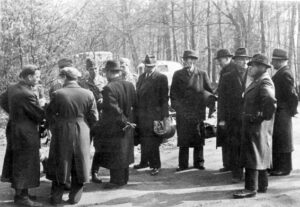 Being arrested is probably one of the scariest things that can happen to a person, especially when they have done nothing wrong. For most of us, that will never happen, but it could, if our government is corrupt and run by a dictator. Such was the case in Nazi Germany. After Hitler was elected, he began to dismantle the police department, filling it with men who were loyal to him. Then, he gave them unlimited authority to go after anyone who disagreed with his plan. These people were not guilty of any crime, they were simply on the wrong side of the political and spiritual agenda of the time.
Being arrested is probably one of the scariest things that can happen to a person, especially when they have done nothing wrong. For most of us, that will never happen, but it could, if our government is corrupt and run by a dictator. Such was the case in Nazi Germany. After Hitler was elected, he began to dismantle the police department, filling it with men who were loyal to him. Then, he gave them unlimited authority to go after anyone who disagreed with his plan. These people were not guilty of any crime, they were simply on the wrong side of the political and spiritual agenda of the time.
The Nazis set out to control every aspect of the lives of the people now under their control…making them little more than servants. It was a very dehumanizing system, whether the people were Jewish, Christian, Agnostic, or Atheist. Even the people who were in Hitler’s “good graces,” knew that one false move would end life as they knew it, or even get them killed. The Third Reich was the final authority in all things…at least at the time. The people were even subject to Hitler’s rules in the privacy of their own homes. The neighbors, and even some of their family members, became spies for the Third Reich. Once a “violation” was reported by anyone, the “perpetrator” was arrested, commonly in the middle of the night, hauled away, and often, never seen again. The Nazi leadership dramatically redefined the role of the police, giving them broad powers, completely independent of judicial review, to search, arrest, and incarcerate real or perceived state enemies and others they considered criminals.
Once a person was arrested, the police could do anything they chose to them to get them to talk…confess to their crimes. The victims of the police taken to Gestapo Headquarters where they were raped, beaten, tortured, enslaved, starved, and often killed, with no repercussions against the police at all. Their actions were considered above the law. They could even do those things to the people on the street, who were not under arrest for anything. The Supreme Court of that day, failed to challenge or protest the loss of judicial authority at this time. In general, it approved of the Nazi leadership’s decisive action. Further, the Supreme Court had been the court of first instance for treason cases since the Imperial period but, by the 1930s, it was overburdened with such trials and had endured relentless criticism from all sides for the judgments it rendered. The court was ultimately relieved to have responsibility for political crimes removed from its jurisdiction. It was another way to remove power from it’s proper place, and put it in the hands of the police, and ultimately Hitler.
The Secret State Police, called the Gestapo, which investigated political opposition, and the Criminal Police, called the Kripo, which handled all other types of criminal activity, were the two civilian forms of law enforcement officers. In addition, Hitler had the SS or the SA, which also imposed public order, but were considered paramilitary forces. The Gestapo was often used “protective custody” (Schutzhaft) to incarcerate people indefinitely, without specific charge or trial. These people were deemed to be potentially dangerous to the security of the Reich. Protective custody had been introduced in the German general law code before World War I to detain individuals for their own protection or to avert an immediate security threat if there were no other recourse. Do not be fooled by this. It was anything, but protective. The Gestapo employed protective custody to arrest political opponents at first, but later Jews, as well as Jehovah’s Witnesses who, because of religious conviction, refused to swear an oath to the Nazi German state or to serve in the armed forces. So, now the people could not speak out politically or religiously, and remember that their gun were also gone. It was a precarious place to be. Hitler was in charge, and he considered anyone who opposed him expendable.
So just imagine, you are asleep in your bed, after a nice Easter dinner with your family, and there comes a knock at the door…or rather a pounding at the door. The door bursts open and the police come in and drag your husband, wife, or even children away with barely a word spoken. No one was exempt. Kids could speak the 
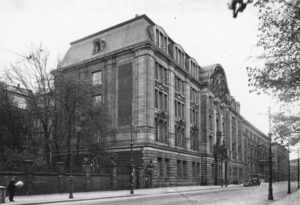 wrong things too. Of course, usually parents were the ones hauled away for what they taught the children. Children were taken into “protective custody” to be retrained in “proper” thinking…in other words, Nazism. Those were perilous times, and times that should never be forgotten. Failing to remember the horrors of the past, opens us up to a repetition of past mistakes in a future time.
wrong things too. Of course, usually parents were the ones hauled away for what they taught the children. Children were taken into “protective custody” to be retrained in “proper” thinking…in other words, Nazism. Those were perilous times, and times that should never be forgotten. Failing to remember the horrors of the past, opens us up to a repetition of past mistakes in a future time.
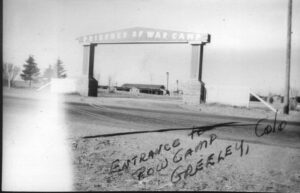 For some reason, when I think of Prisoner of War (POW) camps, I think of a place far away in a war zone, and there were some there, but as they filled up, the prisoners had to be moved to other areas. In addition to that, we needed men to work in the United States because our men were overseas fighting. The prisoners could be put to work in the fields to help grow needed foods for the country, as well as the troops. That idea was a bit foreign to me, especially when I heard that there was just such a camp that was practically in my backyard…even if I wasn’t born at the time. It’s just odd when history collides with your own neighborhood.
For some reason, when I think of Prisoner of War (POW) camps, I think of a place far away in a war zone, and there were some there, but as they filled up, the prisoners had to be moved to other areas. In addition to that, we needed men to work in the United States because our men were overseas fighting. The prisoners could be put to work in the fields to help grow needed foods for the country, as well as the troops. That idea was a bit foreign to me, especially when I heard that there was just such a camp that was practically in my backyard…even if I wasn’t born at the time. It’s just odd when history collides with your own neighborhood.
During World War II, the Greeley, Colorado POW camp had prisoners from Germany and Austria. The camp was built in 1943, and the first prisoners came in 1944. The camp was a self-contained town in itself. It had a fire station, hospital, theater, library, and classrooms. It also had electricity, water, and sewers. The prisoners who were held in the POW camps in the United States were treated well. This country wasn’t into the torture methods that the Axis of Evil nations were.
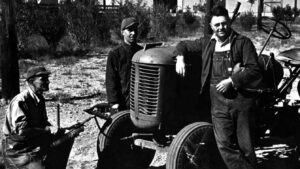
Many of the prisoners worked in the fields and paid money, for their labor, to take home with them. They were also given the chance to have fun. They had soccer teams. They dyed their t-shirts different colors using homemade dyes from vegetables. They had classes in English, German, and Mathematics. Some men were in the camp orchestra and others sang in choir. In many ways, the lives these men lived in the POW camps was better than the lives they lived at home…or at least during the war.
The Greeley POW Camp 202, was almost like a coveted assignment. It was the place the prisoners wanted to be sent. When new prisoners came to the camp, they would try to find men from their hometowns…hoping others had been as blessed as they felt to be there. The story is told that, “The old prisoners would toss out gum or paper with their names and address. One day a father and son found each other from the tossed notes.” These reunions were such a blessing for the prisoners. The guards were well liked. In fact, when one of the guards got married, the prisoners cooked their wedding night dinner for them. These good guards found favor with the prisoners.
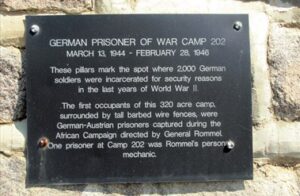
I like to think that POW camps in and run by the United States were and are more civilized than those camps owned and run by other countries, but I don’t suppose all of them were run as compassionately as the Greeley POW Camp. We hear nightmare stories of Guantanamo Bay, and I’m sure there are others that weren’t so great. Still, I suppose things depend on the prisoners to a great degree. It is harder to show kindness to a prisoner who orchestrates a terrorist attack against our nation, killing thousands of innocent people, that it is to be compassionate to a soldier who is simply following orders, but is otherwise a kind and gentle person.
 Apartment living is something many people do, and while they might dream of a house, or even have one, there can be reasons for having an apartment too. The oilfield would be one example of the need for a second place to live. Often, oil field workers must travel to the worksite. Once there, they have to stay there for a time, because traveling to and from home twice a day is just not feasible. Many oilfield companies provide living quarters for their employees. Sometimes it is a local motel, sometimes apartments, and sometimes, as with off shore drilling operations, companies must get innovative.
Apartment living is something many people do, and while they might dream of a house, or even have one, there can be reasons for having an apartment too. The oilfield would be one example of the need for a second place to live. Often, oil field workers must travel to the worksite. Once there, they have to stay there for a time, because traveling to and from home twice a day is just not feasible. Many oilfield companies provide living quarters for their employees. Sometimes it is a local motel, sometimes apartments, and sometimes, as with off shore drilling operations, companies must get innovative.
Some living quarters for oil field workers is quite a bit different than  others. The Edda oil rig in the Ekofisk field, 235 miles east of Dundee, Scotland had just such an unusual housing arrangement for the employees who worked on the Edda oil rig. The Alexander Kielland platform was a floating apartment unit that housed 208 people. The floating apartment complex was located in the North Sea. The majority of the Phillips Petroleum workers were from Norway, but a few were American and British. The platform was held up by two large pontoons. It had bedrooms, kitchens, and lounges, and provided a place for workers to spend their time when not working. It was truly a comfortable home away from home…for the most part.
others. The Edda oil rig in the Ekofisk field, 235 miles east of Dundee, Scotland had just such an unusual housing arrangement for the employees who worked on the Edda oil rig. The Alexander Kielland platform was a floating apartment unit that housed 208 people. The floating apartment complex was located in the North Sea. The majority of the Phillips Petroleum workers were from Norway, but a few were American and British. The platform was held up by two large pontoons. It had bedrooms, kitchens, and lounges, and provided a place for workers to spend their time when not working. It was truly a comfortable home away from home…for the most part.
On March 30, 1980, at about 6:30pm most of the residents were in the platform’s small theater watching a movie. There was a storm brewing, but although there were gale conditions in the North Sea that evening, no one was expecting that a large wave would collapse and capsize the platform. Everything happened very fast. 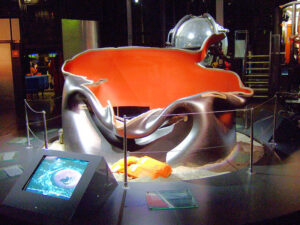 The wave hit, and things began to collapse. Within 15 minutes of the collapse, the floating apartment complex had capsized. It was so fast that many of the workers were unable to make it to the lifeboats. The Royal Air Force of Great Britain and Norwegian military both immediately sent rescue helicopters, but the poor weather made it impossible for them to help. Of the 208 people onboard, 123 drowned. The nightmare scenario seemed impossible, but a subsequent investigation revealed that there was a previously undetected crack in one of main legs of the platform. That had caused the structure’s disastrous collapse. The Alexander Kielland sat in the water for three years before it was salvaged.
The wave hit, and things began to collapse. Within 15 minutes of the collapse, the floating apartment complex had capsized. It was so fast that many of the workers were unable to make it to the lifeboats. The Royal Air Force of Great Britain and Norwegian military both immediately sent rescue helicopters, but the poor weather made it impossible for them to help. Of the 208 people onboard, 123 drowned. The nightmare scenario seemed impossible, but a subsequent investigation revealed that there was a previously undetected crack in one of main legs of the platform. That had caused the structure’s disastrous collapse. The Alexander Kielland sat in the water for three years before it was salvaged.
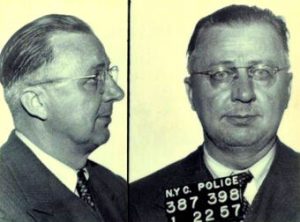 These days, it seems we are hearing about mass shootings, terrorist-type attacks, bombings, and riots, all because people are “disgruntled” about something. It’s like everyone somehow thinks that the best solution to any disagreement is violence. Well, while this type of behavior is not new, it does seem to be happening more and more. Nevertheless, some of the worst attacks weren’t recent, but actually further back in our not so distant past.
These days, it seems we are hearing about mass shootings, terrorist-type attacks, bombings, and riots, all because people are “disgruntled” about something. It’s like everyone somehow thinks that the best solution to any disagreement is violence. Well, while this type of behavior is not new, it does seem to be happening more and more. Nevertheless, some of the worst attacks weren’t recent, but actually further back in our not so distant past.
On March 29, 1951, out of the blue, a homemade bomb exploded at Grand Central Station in New York City. While there were no injuries, commuters were quite startled. It wasn’t as easy to make a homemade bomb in 1951, because the internet didn’t exist. It’s not that the internet is the only place to find instructions on bombmaking, but it has made the process easier. Over the next few months, five more bombs were found at landmark sites around New York, including the public library. Authorities realized that this new wave of terrorist acts was the work of a man they dubbed the Mad Bomber.
This was not the first time New York had been visited by the so-called Mad Bomber. On November 16, 1940, a 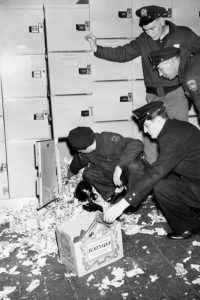 pipe bomb was left in the Edison building with a note that read, “Con Edison crooks, this is for you.” It was a clear indicator of a man who was “disgruntled” with Con Edison over something. What it was all about remained to be seen. Throughout 1941, more bombs were recovered , each more powerful than the last, until in December, the Mad Bomber sent a note stating, “I will make no more bomb units for the duration of the war.” What a strange turn of events. The Mad Bomber was…a patriot!! His letter also stated that Con Edison, New York’s electric utility company, would be brought to justice in due time. I’m not sure whether the people should have been praying for the war to continue, so that the bomber would stop bombing New York; or praying for the horrific war to come to an end. No matter what else he was, the Mad Bomber was not a liar. He made good on his promise, although he sent threatening notes to the press periodically. The year 1951 brought about a flurry of activity, then the Mad Bomber stopped again until 1954 when a bomb went off at Radio City Music Hall. Then in 1955, the Mad Bomber hit Grand Central Station, Macy’s, the RCA building, and the Staten Island Ferry.
pipe bomb was left in the Edison building with a note that read, “Con Edison crooks, this is for you.” It was a clear indicator of a man who was “disgruntled” with Con Edison over something. What it was all about remained to be seen. Throughout 1941, more bombs were recovered , each more powerful than the last, until in December, the Mad Bomber sent a note stating, “I will make no more bomb units for the duration of the war.” What a strange turn of events. The Mad Bomber was…a patriot!! His letter also stated that Con Edison, New York’s electric utility company, would be brought to justice in due time. I’m not sure whether the people should have been praying for the war to continue, so that the bomber would stop bombing New York; or praying for the horrific war to come to an end. No matter what else he was, the Mad Bomber was not a liar. He made good on his promise, although he sent threatening notes to the press periodically. The year 1951 brought about a flurry of activity, then the Mad Bomber stopped again until 1954 when a bomb went off at Radio City Music Hall. Then in 1955, the Mad Bomber hit Grand Central Station, Macy’s, the RCA building, and the Staten Island Ferry.
The police faced a stalemate when it came to finding the Mad Bomber, but finally, an investigative team working for Con Ed tracked him down. Looking through their employment records, they found that George Peter Metesky had been a disgruntled ex-employee since an accident in 1931. Metesky was furious that Con Ed refused to pay disability benefits and, in the end, resorted to terrorism as his revenge. This seems to be the 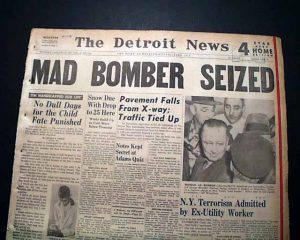 reason a lot of ex-employees resort to violence of some form. They think that because they were wronged, people must die to pay for the injustice they are feeling, never understanding that the people they injure or kill, were completely innocent in that matter. Really!! How dare they do such a thing?
reason a lot of ex-employees resort to violence of some form. They think that because they were wronged, people must die to pay for the injustice they are feeling, never understanding that the people they injure or kill, were completely innocent in that matter. Really!! How dare they do such a thing?
Metesky, had been a rather mild-mannered man, prior to the accident. It was his fury at his injustice that turned him into a monster. Metesky was found to be living with his sisters in Connecticut. Following his capture and trial, he was sent to a mental institution in April 1957 where he stayed until his release in 1973. He died in 1994.

